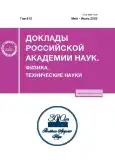DETONATION OF A COMBUSTIBLE GAS MIXTURE UPON THE INTERACTION OF A SHOCK WITH AN ELLIPSOIDAL INERT GAS BUBBLE
- 作者: Georgievskiy P.Y.1, Sutyrin O.G.1
-
隶属关系:
- Institute of Mechanics of Lomonosov Moscow State University
- 期: 卷 510, 编号 1 (2023)
- 页面: 51-58
- 栏目: МЕХАНИКА
- URL: https://journals.rcsi.science/2686-7400/article/view/135942
- DOI: https://doi.org/10.31857/S2686740023030070
- EDN: https://elibrary.ru/OYPGFS
- ID: 135942
如何引用文章
全文:
详细
Interaction of a shock wave in a combustible gas mixture with an ellipsoidal region of an inert gas of increased density is numerically simulated using the Euler equations in two-dimensional plane and axisymmetric formulations. Four qualitatively different regimes of indirect initiation of detonation have been found: upon reflection of a wave from the gas interface, upon focusing of secondary transverse shock waves on the axis/plane of symmetry, upon amplification of a transverse wave converging to the axis of symmetry, and upon secondary focusing of waves in front of the bubble. It is shown that the mode of detonation initiation significantly depends on both the intensity of the shock wave and the shape of the bubble. Based on a series of simulations, the dependence of the threshold Mach numbers of the incident wave on the shape of the bubble is determined. In the plane flow, a moderate elongation of the bubble leads to a significant decrease in the threshold Mach number. In an axisymmetric flow, the lower threshold Mach number is less sensitive to the shape of the bubble, and the most effective detonation initiation is carried out using a spherical bubble. The effect of shock wave focusing makes it possible to achieve successful initiation of detonation at a fundamentally lower intensity of the incident wave compared to direct initiation.
作者简介
P. Georgievskiy
Institute of Mechanics of Lomonosov Moscow State University
编辑信件的主要联系方式.
Email: georgi@imec.msu.ru
Russia, Moscow
O. Sutyrin
Institute of Mechanics of Lomonosov Moscow State University
编辑信件的主要联系方式.
Email: sutyrin@imec.msu.ru
Russia, Moscow
参考
- Apazidis N., Eliasson V. Shock focusing phenomena. Springer, 2018.
- Georgievskiy P.Y., Levin V.A., Sutyrin O.G. Interaction of a shock with elliptical gas bubbles // Shock Waves. 2015. V. 25. № 4. P. 357–369.
- Haehn N., Ranjan D., Weber C., Oakley J., Rothamer D., Bonazza R. Reacting shock bubble interaction // Combustion and Flame. 2012. V. 159. № 3. P. 1339–1350.
- Diegelmann F., Hickel S., Adams N.A. Shock mach number influence on reaction wave types and mixing in reactive shock -bubble interaction // Combustion and Flame. 2016. V. 174. P. 85–99.
- Diegelmann F., Tritschler V., Hickel S., Adams N. On the pressure dependence of ignition and mixing in two-dimensional reactive shock-bubble interaction // Combustion and Flame. 2016. V. 163. P. 414–426.
- Георгиевский П.Ю., Левин В.А., Сутырин О.Г. Детонация горючего газового цилиндра при фокусировке падающей ударной волны // Письма в ЖТФ. 2019. Т. 45. № 23. С. 43–46.
- Георгиевский П. Ю., Сутырин О. Г. Инициирование детонации при взаимодействии ударной волны с горючим газовым пузырем // Доклады РАН. Физика, технические науки. 2022. Т. 503. № 1. С. 35–41.
- Георгиевский П.Ю., Левин В.А., Сутырин О.Г. Детонация горючей газовой смеси при взаимодействии ударной волны с эллиптической областью тяжелого инертного газа // Письма в ЖТФ. 2021. Т. 47. № 9. С. 21–24.
- Korobeinikov V., Levin V. Strong explosion in a combustible gas mixture // Fluid Dynamics. 1969. V. 4. № 6. P. 30–32.
- Matsuo A., Fujiwara T. Numerical simulation of shock-induced combustion around an axisymmetric blunt body // Proc. 26th Thermophysics Conference. 1991. P. 1414.
- Jiang G.-S., Shu C.-W. Efficient implementation of weighted ENO schemes // J. Computational Physics. 1996. V. 126. № 1. P. 202–228.
- He Z., Li L., Zhang Y., and Tian B. Consistent implementation of characteristic flux-split based finite difference method for compressible multi-material gas flows // Computers & Fluids. 2018. V. 168. P. 190–200.
- Haas J.-F., Sturtevant B. Interaction of weak shock waves with cylindrical and spherical gas inhomogeneities // J. Fluid Mechanics. 1987. V. 181. P. 41–76.
补充文件




















